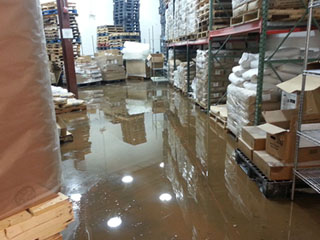How to Reduce Warehouse Energy Costs

Importance of Reducing Energy Costs in your Warehouse
Energy represents one of the largest costs of operating warehouses. An effective energy management plan offers one of the greatest opportunities for improving profitability. New technologies in the areas of temperature control, material handling, lighting and water management make energy use one of the most important considerations in warehouse efficiency. Investing in power reduction systems to decrease energy costs in your warehouse can return your investment in a very short time.
Refrigerated Versus Non-Refrigerated

Energy use varies significantly depending on whether a warehouse is refrigerated or ambient.
Non-refrigerated warehouses in the United States use an average of 6.1 kilowatt-hours (kWh) of electricity and 13,400 Btu of natural gas per square foot annually (E-Source research and advisory service that works with most of the 300 largest electric and natural gas utilities in North America). Lighting and space heating account for approximately 76% of total energy use in such warehouses, making these systems prime targets for energy savings.
In a non-refrigerated warehouse electrical costs typically account for 15% of the operating budget. In refrigerated and cold storage warehouses, up to 60% of the operating costs can be accounted to the electrical use. The chart opposite shows the typical energy usage breakdown for a non-refrigerated warehouse. Lighting accounts for the largest proportion of energy used in the warehouse.
Understanding how your energy provider charges for your power consumption is the first step to reduce warehouse energy costs. Utilities charge commercial buildings for natural gas based on the amount of energy delivered. They charge for electricity based on consumption and demand. The consumption component is calculated on the amount of electricity the building consumes in a month. The demand portion is based on the peak demand in kilowatts that occurs within the month. Some utilities determine the peak demand based on the previous 12 months.
The peak demand charges can quickly increase your bill. The below chart (courtesy of https://ouc.bizenergyadvisor.com/article/warehouses) illustrates the typical peak demand of a non-refrigerated and refrigerated warehouse. You can see that in a non-refrigerated warehouse the peak demand curve is much steeper than in refrigerated. Whereas a refrigerated warehouse consumes a more consistent amount of energy, non-refrigerated consume much less during the night time hours than during daylight hours. Cooling accounts for the largest peak demand in both instances, although lighting in non-refrigerated warehouse makes the largest contribution to peak demand levels. Taking measures to reduce your peak demand has significant impact on your costs. The Mirage Hotel and Casino in Las Vegas made huge savings by installing VFD’s on their refrigeration chilled water system. Not only did the VFD’s reduce energy consumption but they also ramp up the motors when starting up reducing the peak demand dramatically. It can be useful to employ the services of utilities and energy consultancies to review your energy use and advise on areas you can save on energy consumption in your warehouse.
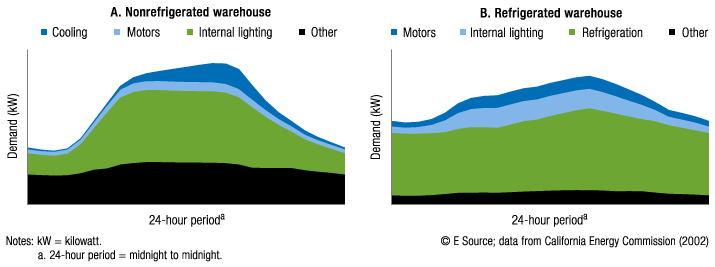
Warehouse Power Consumption “Quick Fixes”
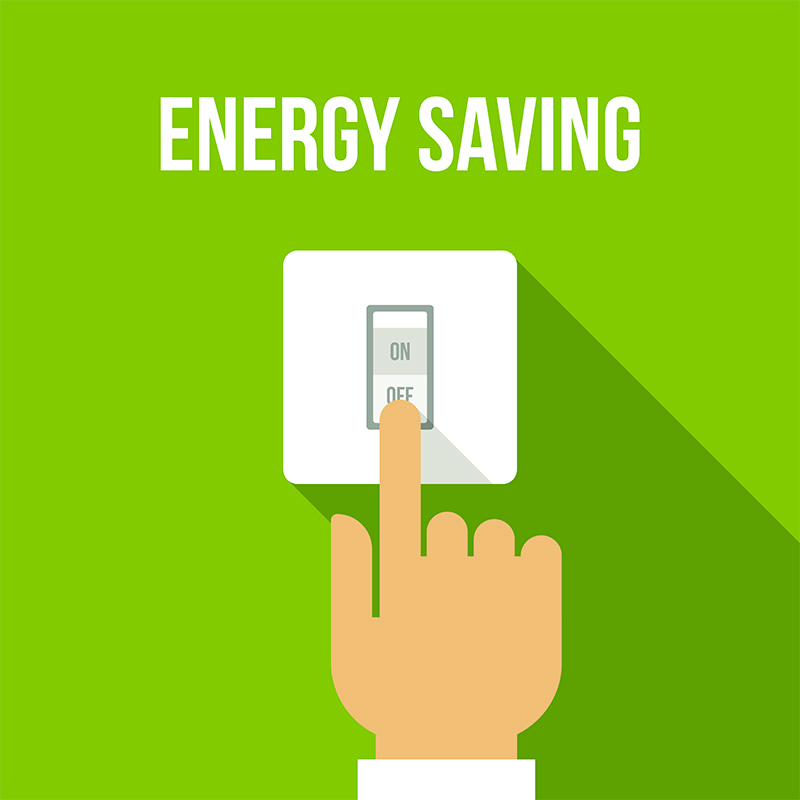 TURN THINGS OFF! One of the simplest and most logical ways to reduce energy costs is to turn off systems that are not in use. Take a walk through your facilities after work hours and check what equipment is left turned on. Much of this equipment could be turned off after hours, and make a prime target for energy cost reduction. For example, a computer workstation monitor and shared printer consume overnight approximately 120 Watts. If left on overnight and weekends that single workstation can add $30 per annum to your electrical bill. A large warehouse and distribution facility could conceivably have 100 workstations, resulting in $3,000 of cost savings per year.
TURN THINGS OFF! One of the simplest and most logical ways to reduce energy costs is to turn off systems that are not in use. Take a walk through your facilities after work hours and check what equipment is left turned on. Much of this equipment could be turned off after hours, and make a prime target for energy cost reduction. For example, a computer workstation monitor and shared printer consume overnight approximately 120 Watts. If left on overnight and weekends that single workstation can add $30 per annum to your electrical bill. A large warehouse and distribution facility could conceivably have 100 workstations, resulting in $3,000 of cost savings per year.
Lighting, as already discussed above, is the largest power cost in a non-refrigerated warehouse. Installing occupancy sensors and motion detection controls for lights will automatically turn them on or off based on movement. This means less used corridors and rooms in your facilities will be dark when not in use, reducing carbon footprint and saving energy costs in the process.
Maintenance that saves energy use
Maintenance of your facilities services can result in reduced warehouse energy costs. Regular maintenance of HVAC systems, changing and cleaning of filters and reviewing your temperature set points all contribute to a more efficient HVAC system. More efficiency means lower energy usage and costs. Installation of VFD’s on chiller plant systems not only saves energy costs but also maintenance by putting less stress on your chilled water system components.
Long term energy saving solutions for warehouses
The above listed solutions are quick fixes, and although they will provide benefit for minimal investment, taking a longer term approach and investing more into your warehouse energy management plan will pay off in the long run. The following improvements and changes to your warehouse energy management will result in greater cost savings.
Enterprise Energy Management System
Before you can manage and reduce warehouse energy costs you need to be able to measure it. How do you identify power hungry areas of your facilities, and how do you analyze and quantify the effect your measures are having? An Enterprise Energy Management System (EEM) will enable you to track your facilities energy usage with reports and performance analytics. The EEM will pull in data from multiple systems in your facilities to give a broad understanding of your warehouse energy consumption. If you have multiple facilities the data can be used to compare performance and costs of your different facilities. Factors such as outside air temperature are even considered. Higher outside air temperatures result in higher demand for HVAC systems. If HVAC systems are not sized correctly the compressors will be over utilized, running constantly, using more energy. The EEM can also give an insight into the a dual cost savings achieved, and efficacy of your deployed solutions.
Energy Efficient Lighting
 As we have seen, lighting is one of the biggest energy hogs in the warehouse. This makes it the prime target for energy saving measures. Lighting technology has improved over recent years resulting in a shift away from typical high ay lighting systems of old that used Fluorescent Tubes and Metal Halides. LED lighting technology for the warehouse offer many advantages.
As we have seen, lighting is one of the biggest energy hogs in the warehouse. This makes it the prime target for energy saving measures. Lighting technology has improved over recent years resulting in a shift away from typical high ay lighting systems of old that used Fluorescent Tubes and Metal Halides. LED lighting technology for the warehouse offer many advantages.
- Longer life
- Better light distribution pattern
- Improved cold condition performance
- Lower energy usage
LED lighting have a faster startup time and less degradation through power on/off cycles when compared with traditional lighting systems. This makes LED lighting better suited for control via occupancy and motion detection sensors. Typically upgrading to LED lighting systems can save 30% of your energy costs.
Another strategy employed by many warehouses is the use of skylights that bring in natural and free daylight. These can be paired with timers that control the interior lighting. So during daylight hours the natural skylights are sufficient, and as night time approaches interior lighting systems are turned on. This means you no longer rely on employees to remember to turn lights on and off.
Chiller System Optimization
Warehouses that are climate controlled can have varying degrees of reliance on their HVAC or chilled water systems. There are regulatory requirements for certain foodstuffs and pharmaceuticals for storage. However, you can comply with these temperature controlled storage requirements but still save energy. A moderately oversized chiller system with a VFD installed can be highly effective at saving energy costs. Proper sizing of the whole chiller system, evaporator coils VFD controlled fans will make further savings by optimizing the chiller efficiency.
Warehouse Building Insulation
Installation of high performance insulation to the buildings structure will make huge savings in Heating or cooling energy. It enables you to maintain a more stable temperature throughout the warehouse. Temperature fluctuations lead to increased load on heating or cooling systems to bring the conditions back to within the allowed parameters. Therefore, installing a good insulation barrier in the roofing system and walls, segregating areas that need to be cooled/heated and those that don’t, all help to reduce warehouse energy costs.
DPI Northwest – Warehouse Energy Consumption Reduction
As an example, DPI Northwest, a division of Ontario, California-based DPI Specialty Foods, worked with Pacific Energy Concepts, an energy consultant, to explore its lighting options. The company wanted to reduce energy costs and improve lighting quality for employees.
The company found its options included light-emitting diode (LED) fixtures in specific areas that would perform well in refrigerator and freezer environments. In addition to improving brightness and visibility throughout the facility, the upgrades would save energy, reduce costs and qualify for incentives from the Energy Trust of Oregon, a local utility company, according to an Energy Trust of Oregon case study.
LEDs, unlike fluorescent lights, provide instantaneous illumination. Plus, they are cooler so they don’t add heat to the freezer, which provides additional energy savings. LEDs also replaced several exterior fixtures on the loading docks, entrances and parking lot poles.
Many of the LED and fluorescent fixtures included occupancy sensors and wireless controls for additional energy efficiency. The fixtures can be programmed to operate according to different lighting levels, timing options and motion activation, also saving energy.
DPI Northwest reported a 12 percent decrease per day in energy consumption. Since 90 percent of the building is refrigerated, the decrease delivered a significant energy savings.
Kane Is Able Inc – Warehouse energy Consumption Reduction
As another example, Kane Is Able Inc., a 3PL with locations across the United States, recently completed a 1.2 million square foot LED lighting upgrade in two DCs located in its main business campus, says Alex Stark, senior director of marketing. R World Energy Solutions installed the lighting. The upgrade is projected to save more than 2 million kWh annually with the added benefit of eliminating the emission of 2.7 million pounds of greenhouse gases each year.
Additionally, Kane Is Able continues to participate in the Environmental Protection Agency’s (EPA’s) SmartWay program, which it has done since 2006. The 3PL supports the program’s emission reduction initiatives by purchasing EPA-designated SmartWay tractors and trailers. The company’s recent update of its diesel-powered tractor fleet is expected to save $1.3 million and 343,000 gallons of diesel annually.
Ryder Systems Inc. Install LEED Certified Skylights

Ryder System Inc.’s energy conservation strategy includes sourcing energy efficient buildings equipped with skylights, preferably LEED certified, says Nanci Tellam, group director of environmental services and sustainability. LEED refers to Leadership in Energy and Environmental Design (LEED) certified by the U.S. Green Building Council for environmental performance.
The company converts lighting in existing buildings from metal halide to fluorescent and LED fixtures. It also installs motion and daylight sensors and equips the lighting system with on/off controls. The controls allow the lighting to be controlled by zone (e.g., unoccupied warehouse space is fully equipped with light fixtures but the area is lit just for security purposes).
In addition to the facility design and criteria of the building itself, Ryder places a great deal of emphasis on many other factors, such as:
- Incorporating energy-use selection criteria in pre-acquisition due diligence reviews for equipment,
- Establishing routine repair and maintenance programs for high energy-use equipment, such as HVAC systems, to ensure optimum performance,
- Implementing a formal process to identify and acquire/occupy greener facilities and buildings, or working with landlords to improve building efficiencies,
- Tracking, measuring and reporting energy use and greenhouse gas emissions, and
- Sub-meter key systems, such as HVAC, battery charging systems, conveyor and packaging equipment, refrigeration and other energy intensive aspects of the facility.
How can AKCP Help?
AKCP PMS
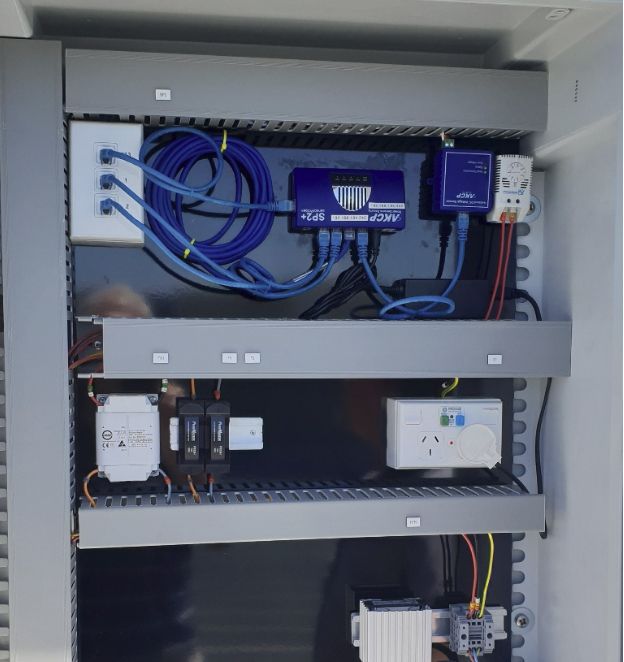 Using our AKCP Power Monitoring Sensors (PMS) along with our CT’s (Current Transformers) you can constantly monitor all of your AC powered equipment, including high AC current by implementing our split type CT’, so you don’t have to disconnect high current lines.
Using our AKCP Power Monitoring Sensors (PMS) along with our CT’s (Current Transformers) you can constantly monitor all of your AC powered equipment, including high AC current by implementing our split type CT’, so you don’t have to disconnect high current lines.
The variables you can monitor with our PMS include sub-metering key systems, such as your HVAC, battery charging systems, conveyor and packaging equipment, refrigeration and other energy intensive aspects of your warehouse facility.
This includes constant graphing of your power consumption for each of your systems, reports and also alerting via SNMP, SMS, E-mail.
AKCP Monitors HVAC systems in New Zealand
AKCP ILPM
Use our AKCP In Line Power Meter Sensors (ILPM) to monitor AC voltage and Current in power strips and other AC equipment to constantly monitor and graph voltage and current usage trends throughout your warehouse to pinpoint AC power and current usage.
AKCP Dual Temperature / Humidity
Combine our AKCP Temperature Sensors for monitoring your warehouse temperature for hot spots and reduce power consumption due to high and low temperatures or wasted energy due to temperature and humidity.
Customer Story – Cold Storage Temperature Monitoring
AKCP Monitors Cold Storage for Naivas
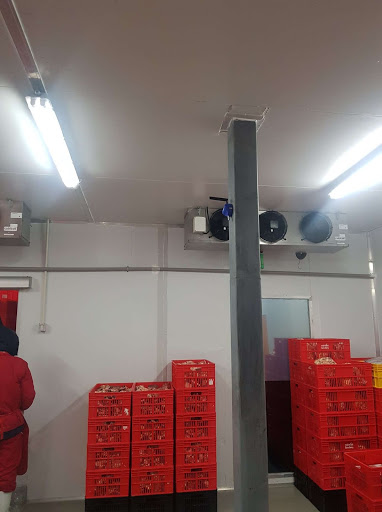
AKCP Dry Contact Sensors
Use our AKCP Dry Contact Sensors as inputs or outputs to monitor and control LED and auto warehouse lighting systems in separate segments of your warehouse to save on lighting costs.
AKCP Motion Sensors
Use our AKCP Motion Detection Sensors for monitoring, detecting and controlling warehouse lighting systems by detecting movement in your warehouse to save on lighting costs. Our Motion Detection Sensors can be used to detect motion, for example in entry and exit doors or other areas of your warehouse that can then be tied to controlling (turning on & off) lighting or other systems in order to save on energy costs.
Remote Access 24/7
To properly maintain the consistent optimal environment required for your warehouse, it is recommended that these conditions be checked on an hourly basis even during off hours, weekends or holidays. During this downtime, you can easily access the sensorProbe, sensorProbe+ series and LoRa L-DCIM 24/7 by simply logging into the unit’s web user interface remotely using your browser via secure HTTPS.
Instantaneous Sensor Data Graphing Built In
Our AKCP sensorProb2+, sensorProbeX+ and Wireless Tunnel™ L-DCIM IP based units all include advanced sensor data graphing that allows you to create custom reports based on each sensor, time period etc.
Centralized Remote Site Management Software
If you have a single warehouse, or several and you need a centralized management solution, then our AKCPro Server is the answer. When you have multiple warehouses spread over a wide geographic area and require to monitor them from a single central office, or even from your home location, the AKCPro Server is the ideal solution. the ideal choice.
Our AKCP base units at remote sites can communicate by sending the sensor data via a GSM modem and secure VPN connection.



